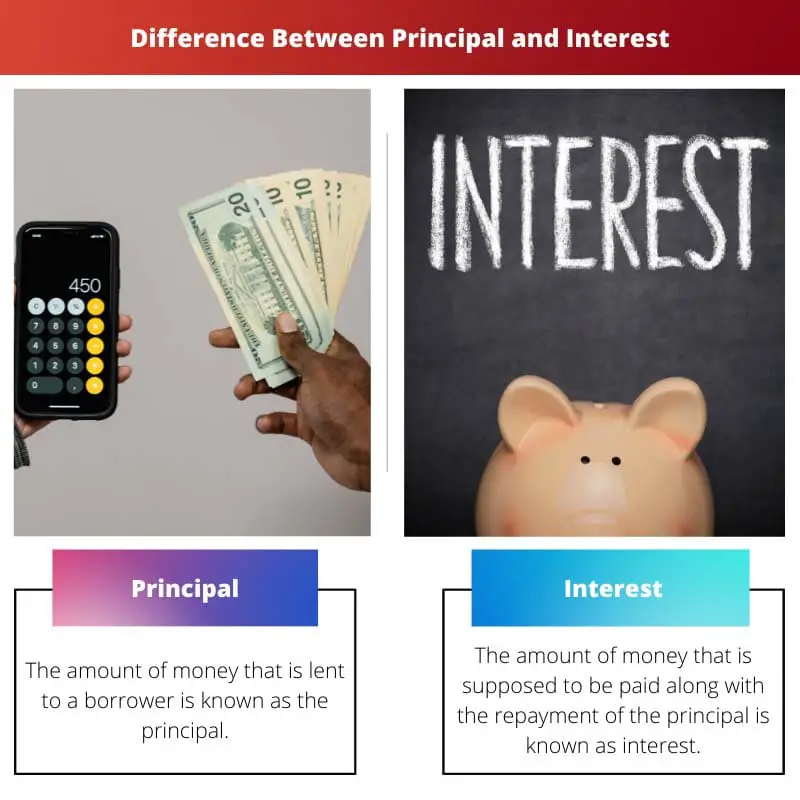There exist several financial areas that engage in a lot of transactions with various parties and people in general. The world of commerce has immensely developed, and many changes have been made to the processes that take place.
There are several transactions and other processes that take place between several organizations, parties, people and banks as well.
Whenever a person borrows money from a certain institution, there are some procedures or methods levied when the person has to return the borrowed money.
Two such terminologies or methods that are used are 1. Principal, and 2. Interest.
Key Takeaways
- The principal is the initial amount of money borrowed or invested.
- Interest is the amount paid for using borrowed money or earned on invested money.
- The interest amount is calculated as a percentage of the principal amount.
Principal vs Interest
The difference between principal and interest is their meaning or definition. The total amount of money that is borrowed from a person or that is invested by a person on which a certain amount of interest is levied is known as the principal, on the other hand, the amount of money that is supposed to be paid along with the repayment of the principal is known as interest.

The amount of money that is lent to a borrower is known as the principal. In the financial world, the term “principal” has several meanings depending on the context.
For instance, the principal is the initial amount of loan that a borrower must repay, on the other hand, the main parties that are involved during various transactions are also known as principals in the context of contracts and ventures.
The amount of money that is supposed to be paid along with the repayment of the principal is known as interest. It is a type of monetary charge. The history of compound interest dates back to 2400 BC.
It was considered one of the necessary steps for growth in areas like agriculture and urbanisation. However, charging interest during medieval times was considered morally invalid.
Comparison Table
| Parameters Of Comparison | Principal | Interest |
|---|---|---|
| Meaning/ Definition | The amount of money that is lent to a borrower is known as the principal. | The amount of money that is supposed to be paid along with the repayment of the principal is known as interest. |
| Formula | P= I/ RT | Simple interest = P•R•T/ 100 |
| Subtypes | Bonds, investments, loans, companies, transactions | Fixed interest, variable interest, annual percentage rate, prime rate, discount rate, simple interest, compound interest. |
| Type of | Borrowed amount | Extra amount or a monetary charge |
| Related terms | Bonds, face value, market value, investments, loans, private companies etc. | Simple interest, compound interest, interest rate, prime rate etc. |
What is Principal?
The amount of money that is lent to a borrower is known as the principal. The principal is the amount that is borrowed by the borrower from a certain financial institution or any other resource.
In the financial as well as the business world, the term “principal” has various interpretations depending on its usage.
For instance, the principal is the initial amount of loan that a borrower must repay, on the other hand, the main parties that are involved during various transactions are also known as principals in the context of contracts and ventures.
Other than that, the majority of stakeholders in a company in business is also referred to as principal.
The original amount of money committed by an investor at the time of purchase of assets is also called principal. The resolution of the amount of interest that is supposed to be paid by the borrower is based on the amount of the principal.
The interest rate that is supposed to be levied is also determined based on the amount of principal.
All in all, one can interpret that the amount of money borrowed is known as a loan, the money invested by an investor during an investment, the face value possessed by a bond, and other transactions and companies are also considered types of principal.

What is Interest?
The amount of money that is supposed to be paid along with the repayment of the principal is known as interest. It is a type of monetary charge. The history of compound interest dates back to 2400 BC.
It was considered one of the necessary steps for growth in areas like agriculture and urbanisation.
During the Renaissance era, there was an increase in commerce, and many entrepreneurs initiated lucrative business ideas. This gave rise to the usage of interest during the transactions that were carried out.
However, charging interest during medieval times was considered morally invalid.
Several types of interest include fixed interest, variable interest, annual percentage rate, prime rate, discount rate, simple interest, and compound interest.
These types have their independent meaning and usage in the financial as well as in the business world. The interest rate depends on the principal amount, and it is determined based on the amount of principal the borrower borrows.
The fixed interest is a fixed amount of money that is supposed to be paid during the repayment of the principal by the borrower. Variable interest, on the other hand, is completely different from fixed interest.
The amount of interest in the variable interest fluctuates depending on the ongoing movement of base interest rates.
The annual percentage rate interest is the interest that is levied annually along with the principal. The economic world has a different meaning of interest. It is considered the price of credit, and it also plays the role of cost of capital.
Different places have different inter of the term “interest”.

Main Differences Between Principal and Interest
- The total amount of money that is borrowed from a person or that is invested by a person on which a certain amount of interest is levied is known as the principal, on the other hand, the amount of money that is supposed to be paid along with the repayment of the principal is known as interest.
- The principal is an independent entity, on the other hand, interest is an entity that is dependent on the principal. If the principal is not borrowed, then the interest won’t exist.
- The principal is a borrowed amount, on the other hand, the interest is an extra amount of a type of monetary charge.
- The types of principals include bonds, investments, loans, companies, transactions etc, on the other hand, the types of interest include fixed interest, variable interest, annual percentage rate, prime rate, discount rate, simple interest, compound interest etc.
- The formula that is used to calculate principal is P= I/ RT, on the other hand, is a formula that is used to calculate simple interest is, Simple interest = P•R•T/ 100.

- https://search.proquest.com/openview/a081b45b7e66e89391308164f90c4a6f/1?pq-origsite=gscholar&cbl=3330
- https://heinonline.org/hol-cgi-bin/get_pdf.cgi?handle=hein.journals/duklr1981§ion=41

This is a detailed explanation of the difference between principal and interest. Thank you for breaking down the key takeaways and explaining the meaning of each term.
I agree, it’s a very comprehensive comparison of the two concepts.
I appreciate the detailed elaboration on the historical evolution of charging interest, adding depth to the understanding of its significance in financial matters.
I certainly agree, the historical narrative enriches the discussion.
Absolutely, the historical context is a valuable element in understanding the broader implications of charging interest.
The distinctions between principal and interest were explained with great precision, making it easier to comprehend for those who may be new to financial terminology.
Agreed, the detailed comparison makes the topic accessible to a wider audience.
The comparison table has been structured in a very organized and informative manner, clearly delineating the differences between principal and interest.
I found the formulaic comparison particularly helpful in understanding the mechanics of principal and interest.
The breakdown of what constitutes principal and interest, along with their respective roles in financial dealings, has been presented with great clarity.
Yes, the focus on historical context adds an interesting dimension to the topic.
I liked the historical context provided about the origins of charging interest.
The article provides a comprehensive overview of what constitutes principal and interest, and how they are intertwined with various financial dealings.
Indeed, the contextualization of the terminology makes it easier to grasp.
The breakdown of the related terms associated with principal and interest is especially useful.
This article would serve as a valuable resource for anyone looking to understand the nuances of principal and interest, and their applications in financial processes.
The article covers the essential aspects of principal and interest comprehensively, making it an enlightening read for those interested in the topic.
Absolutely, the content is insightful and well-presented.
The article efficiently outlines the parameters of comparison between principal and interest, shedding light on their respective meanings and the various subtypes associated with each.
Absolutely, the comparison table was particularly helpful in understanding the differences.
I found the historical context provided about the origin of compound interest quite intriguing. It adds depth to the discussion.
This article provides an insightful overview of the fundamental concepts of principal and interest, and the significance of each in financial transactions.
Absolutely, a very informative piece indeed.